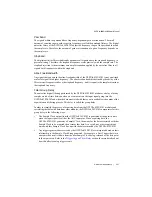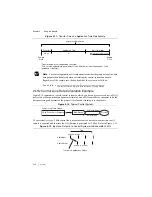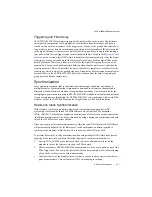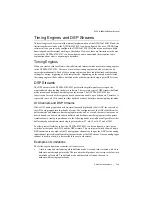
2-4
|
ni.com
Chapter 2
Using the Module
Connecting Ground-Referenced Voltage Signal Sources
A ground-referenced signal source is a signal source connected to a common ground point with
respect to the measurement device.
The difference in ground potential between two instruments connected to the same building
power system is typically between 1 mV and 100 mV, but the difference can be much higher if
power distribution circuits are improperly connected. If a grounded signal source is incorrectly
measured, this difference can appear as measurement error. Follow the connection instructions
for grounded signal sources to eliminate this ground potential difference from the measured
signal.
Figure 2-6 shows how to connect a ground-referenced signal source to an NI PXIe-4302/4303
with a TB-4302.
Figure 2-6.
Connecting Ground-Referenced Signal Sources
With this type of connection, the NI PXIe-4302/4303 rejects both the common-mode noise in
the signal and the ground potential difference between the signal source and the device ground,
shown as V
cm
Connecting Thermocouple Signals
Note
The TB-4302 terminal block is required when measuring a thermocouple
signal.
For floating thermocouples, refer to the
Connecting Floating Signal Sources
section to bias the
differential input of the NI PXIe-4302/4303.
For ground-reference thermocouples, refer to the
Connecting Ground-Referenced Voltage
Cold-Junction Compensation
Cold-junction compensation is the process of measuring the temperature of the screw terminal
junction of the thermocouple and applying it to compensate the temperature measured by the
thermocouple input channel. The TB-4302 has an onboard temperature sensor to measure the
PXIe-4
3
02/4
3
0
3
TB-4
3
02
AI+
AI–
AIGND
+
–
Gro
u
nd-
Referenced
S
ign
a
l
S
o
u
rce
+
–
Common-
Mode
Noi
s
e
a
nd
Gro
u
nd
Potenti
a
l
AI+
AI–
AIGND
V
s
V
cm












































